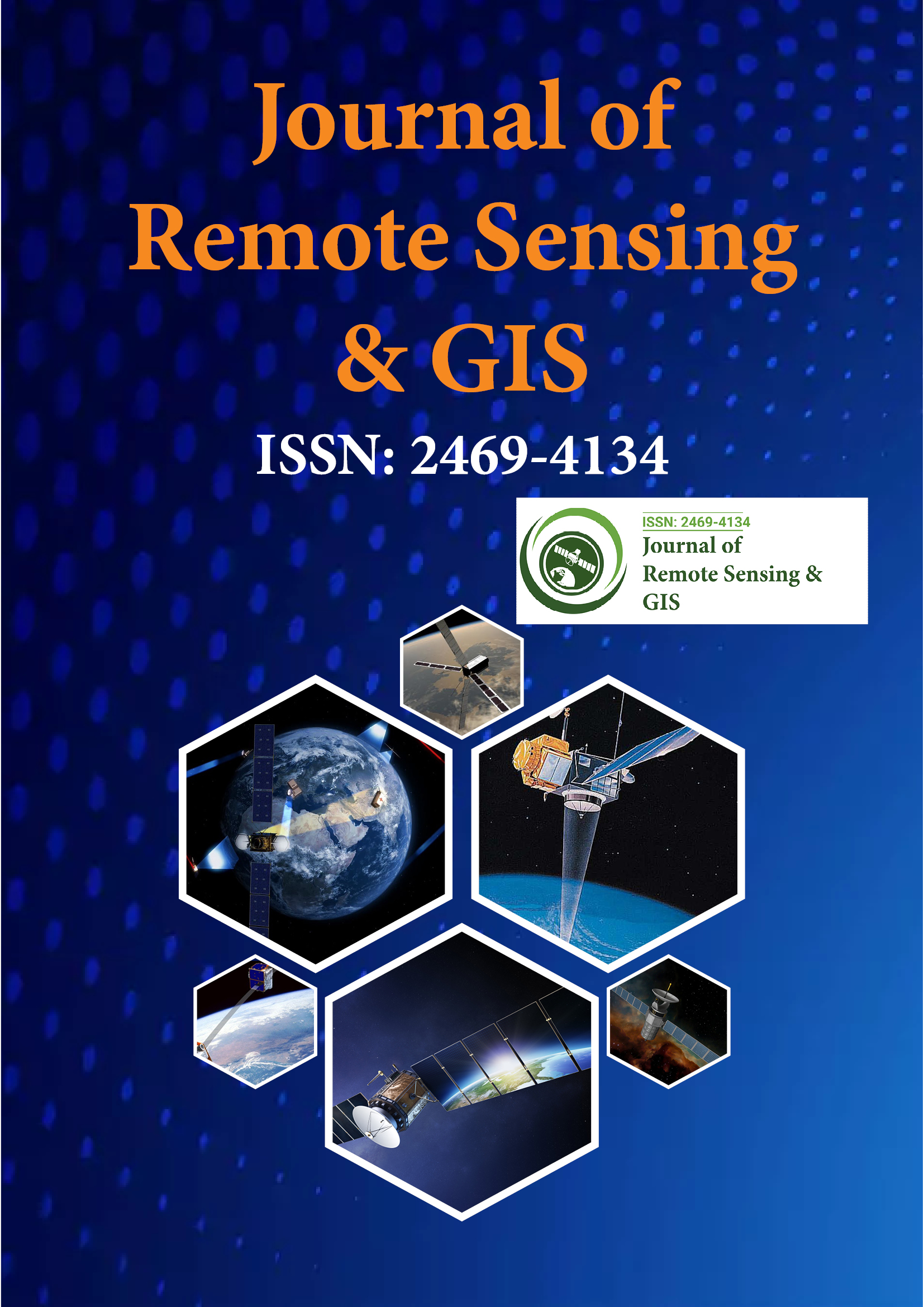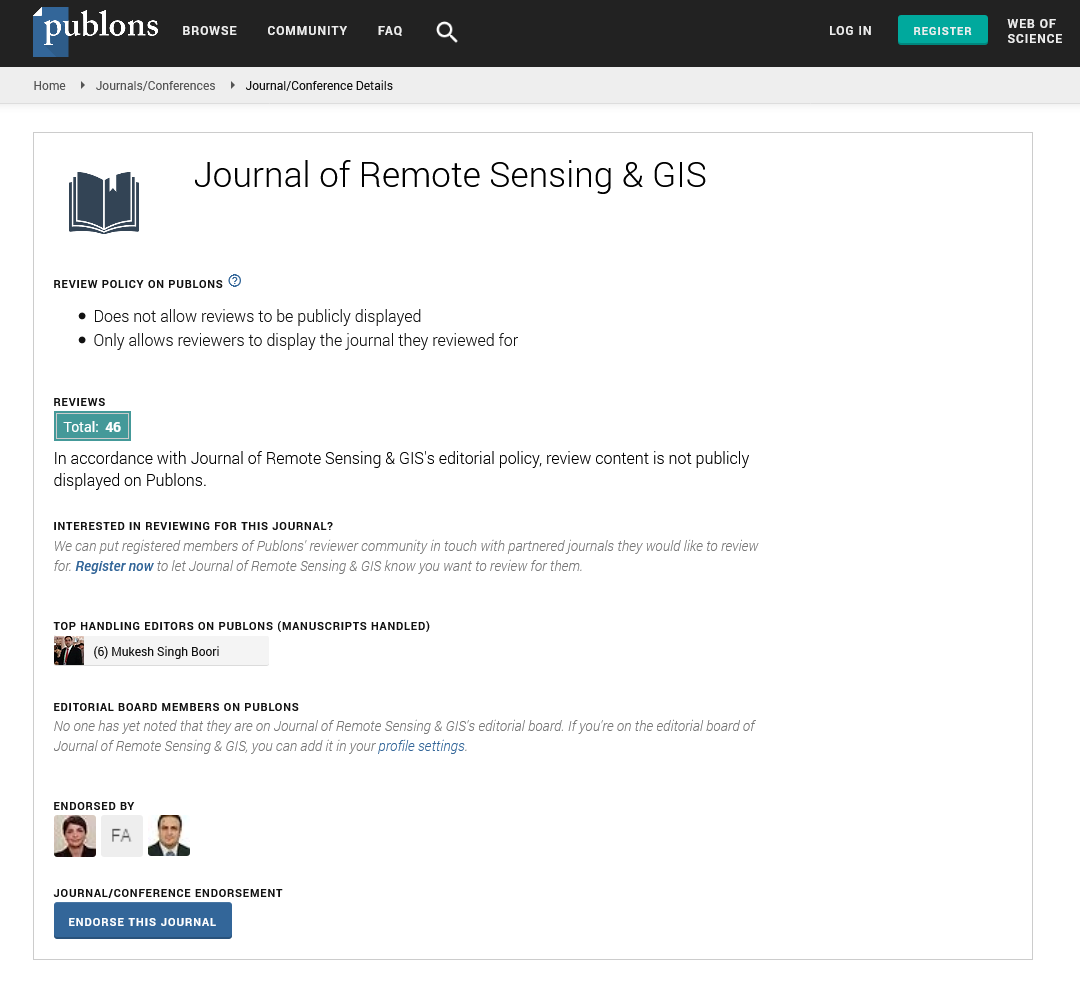Indexed In
- Open J Gate
- RefSeek
- Hamdard University
- EBSCO A-Z
- OCLC- WorldCat
- Publons
- International Scientific Indexing
- Euro Pub
- Google Scholar
Useful Links
Share This Page
Journal Flyer

Open Access Journals
- Agri and Aquaculture
- Biochemistry
- Bioinformatics & Systems Biology
- Business & Management
- Chemistry
- Clinical Sciences
- Engineering
- Food & Nutrition
- General Science
- Genetics & Molecular Biology
- Immunology & Microbiology
- Medical Sciences
- Neuroscience & Psychology
- Nursing & Health Care
- Pharmaceutical Sciences
Perspective - (2025) Volume 14, Issue 2
GIS Applications in Public Health for Disease Outbreak Tracking
Griffith Nelson*Received: 06-Jun-2025, Manuscript No. JGRS-25-29358; Editor assigned: 09-Jun-2025, Pre QC No. JGRS-25-29358 (PQ); Reviewed: 23-Jun-2025, QC No. JGRS-25-29358; Revised: 30-Jun-2025, Manuscript No. JGRS-25-29358 (R); Published: 07-Jul-2025, DOI: 10.35248/2469-4134.24.14.385
Description
In recent decades, the world has experienced a growing number of infectious disease outbreaks, both emerging and re-emerging, many of which have posed significant public health challenges. In response, public health systems have increasingly turned to geospatial tools for timely detection, monitoring, and containment of diseases. Geographic Information Systems (GIS) offer an effective platform for mapping, analyzing, and visualizing the spatial distribution of health events. By integrating epidemiological data with environmental, demographic, and infrastructural information, GIS enhances understanding of disease dynamics and supports data-informed public health interventions.
GIS enables the spatial representation of disease incidence, revealing patterns that may not be apparent in traditional tabular reports. By mapping case locations and correlating them with potential risk factors such as water sources, population density, climate zones, or transportation networks public health authorities can identify clusters and trace the origin and spread of infections. Such spatial insights are valuable during the early stages of an outbreak, when swift containment is necessary to prevent further transmission.
In vector-borne diseases like malaria, dengue, or chikungunya, GIS plays a central role in identifying habitats conducive to vector breeding. Environmental layers such as land cover, elevation, rainfall, and temperature can be overlaid with disease data to generate risk maps. These maps help target vector control measures, such as larvicide spraying or distribution of insecticide-treated bed nets, to the areas most in need. In areas with limited resources, this spatial targeting ensures more efficient use of available interventions.
During waterborne disease outbreaks, GIS assists in tracing contaminated water sources and identifying affected communities. Mapping the distribution of cholera cases, for example, in relation to wells, rivers, or sanitation infrastructure helps reveal the source of contamination. This enables health workers to implement corrective actions such as disinfection, distribution of safe water, or temporary relocation of affected populations. Furthermore, GIS can model the potential spread of disease through water flow simulations, which is especially important in flood-prone or poorly drained regions.
One of the most valuable features of GIS is its capacity for realtime or near real-time data visualization. Integrated with mobile data collection tools, GIS platforms allow health workers to input case information, geotag locations, and update records instantly. Dashboards developed using GIS software can display live updates on case counts, hotspots, resource allocation, and containment progress. Such visualizations improve coordination among stakeholders, guide resource distribution, and facilitate communication with the public.
The role of GIS in respiratory disease outbreaks has become particularly evident in global responses to diseases like COVID-19 and influenza. During the COVID-19 pandemic, geospatial dashboards were used to monitor infection trends, predict outbreak trajectories, and manage vaccine distribution. Population mobility data, obtained from mobile devices and transport networks, were incorporated to assess transmission risk and guide lockdown policies. GIS also helped in site selection for testing centers, quarantine facilities, and temporary hospitals by considering spatial accessibility and population coverage.
GIS is also valuable for long-term disease surveillance and health risk modeling. Historical disease records, when geocoded and analyzed over time, reveal recurring patterns and seasonal trends. For instance, by examining past outbreaks of leptospirosis or typhoid in specific districts, health authorities can predict highrisk periods and implement preventive measures in advance. Predictive models that incorporate climate data, land use change, and human behavior patterns enhance preparedness by identifying likely hotspots before outbreaks occur.
Beyond infectious diseases, GIS supports public health in areas such as chronic disease surveillance, maternal and child health, and environmental exposure assessment. Mapping the incidence of non-communicable diseases like diabetes, hypertension, or asthma alongside air pollution data or food access reveals disparities in health outcomes and environmental justice. In disaster-prone regions, GIS helps assess population vulnerability by combining demographic indicators with exposure to hazards, thereby improving emergency planning.
Education and outreach efforts also benefit from GIS tools. By translating complex data into accessible maps, GIS platforms help convey health risks to communities and policymakers. Interactive story maps, for example, combine geospatial visuals with narrative text to explain outbreak patterns, intervention strategies, or public health campaigns. This approach increases public understanding and supports behavior change.
Despite its many advantages, effective GIS application in public health requires reliable data, trained personnel, and appropriate infrastructure. Data quality, consistency, and privacy concerns must be addressed, especially when dealing with personal health information. In many low-resource settings, gaps in health reporting systems and limited internet connectivity can hinder the real-time utility of GIS. Capacity building, partnerships, and investment in digital health infrastructure are necessary to overcome these challenges and expand GIS adoption.
In conclusion, GIS has become an indispensable tool in public health for disease outbreak tracking and health system planning. Its ability to integrate diverse data types, visualize spatial patterns, and support real-time decision-making has improved the speed and precision of outbreak response. From infectious disease containment to long-term health surveillance, GIS strengthens public health efforts by linking data to place. As health systems continue to evolve in a data-driven world, the role of geospatial analysis will become increasingly central in protecting and promoting population health.
Citation: Nelson G (2025). GIS Applications in Public Health for Disease Outbreak Tracking. J Remote Sens GIS.14:385.
Copyright: © 2025 Nelson G. This is an open-access article distributed under the terms of the Creative Commons Attribution License, which permits unrestricted use, distribution and reproduction in any medium, provided the original author and source are credited.

